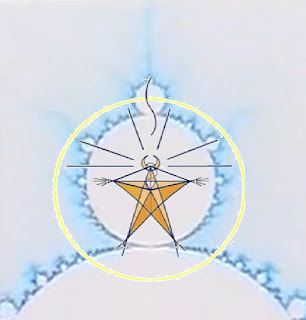The ultimate focus of somatic education is not the muscular system or the brain -- both of which are 3rd person concepts, only -- but the field of feeling. Somatics is primarily about feeling (or sensing) and movement -- to be understood in just those terms.
As a practical matter, most people are largely oblivious to the field of feeling; "feeling" is even disparaged in today's left-brain-analytical culture of science and control. Because of that untrained obliviousness, most people cannot attend to the field of feeling very well, in the practice of somatic education action patterns ("exercises") or in life, in general -- and for that reason, as a practical matter, people must start with feeling muscular activity to awaken to the overall field of feeling -- which is not shaped like a human body, with two arms, two legs, a head and a trunk. The shape of the field of feeling is spherical.
It doesn't seem spherical, for most people, because what they feel primarily are areas of pain or pleasure (occasional moments of sensation) and areas of themselves that they have specifically awakened by participating in various activities. So, the sphere isn't "filled out".
However, as areas and intensities of pain diminish and sensory (or feeling-) attention awakens, the sphere of feeling does fill out.
That spherical field of feeling has a boundary that does not exist at the skin, but extends beyond it and fades as it extends outward, fades first into a kind of subtle feeling of attention-presence and then fades further into an incomprehensible "unknown Unknown". The sense of self, and general feeling-attention, exists within the confines of that spherical shape. All sensations exist within it -- physical sensations, emotional sensations, and mental sensations (the feeling of thinking). Attention, intention, memory, and imagination operate with the "unknown Unknown" at the far periphery of the spherical field of feeling. The sense of objects and of others appears within it.
Just as pains and pleasures tend to "shape" the field of feeling, so also do subjective occupations, such as reveries, dreams, memories, conceptualizing and stress-states. Reveries, dreams, memories, conceptualizing, and stress states contract -- constrict -- the spherical field of feeling and appear to define us into the shape of human somas that feel the way we look.
Just as somatic education action patterns free us from the habituated muscular constrictions of sensory-motor amnesia, somatic education in the form of the TetraSeed Awakening Invocations, or other disciplines of mind and attention, frees us from the habituated stress-constrictions of attentional-intentional amnesia. As that happens, feeling-intuition progressively reveals our form to be (in the rest condition) spherical, and (in activity), modifications of that sphericality.
As a note of interest, if you pay attention in this moment to the feeling of your bodily form, you will notice that it has places where sensation is prominent and where it is less or absent. When you move, new places of sensation light up; when you come to rest, they fade out in seconds. What is commonly left is the feeling of mind, or attention, flickering from subject to subject, object to object.
"Mind" is a kind of subtle, internal feeling-attention. When mind comes to rest (as in the practice of TetraSeed Awakening Invocations or other disciplines of transcendence), even that subtle, internal feeling-attention subsides and we lose the sense of self-and-world altogether.
To retain any sense of defined form requires movement or change of some sort, whether of muscular movement or the movements of attention. The most common form of sensation produced by muscular movement is that of breath and heartbeat, the waves and pulsings of which keep the non-spherical sense of the body more or less continuous, from moment to moment. When attention ceases to be directed to, or distracted by, these waves and pulsings, they also fade out. This, in the language of yoga, is called samadhi.
In samadhi, we do not go unconscious; the sense of consciousness persists, but in a non-self-conscious way that feels entirely ordinary and congenial. It is only when we come out of samadhi that the world (or the room we occupy) surprises us with its (really, our) re-emergence.


No comments:
Post a Comment